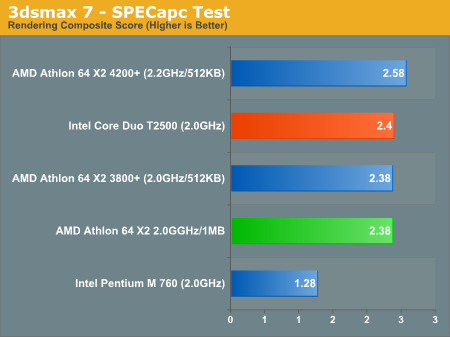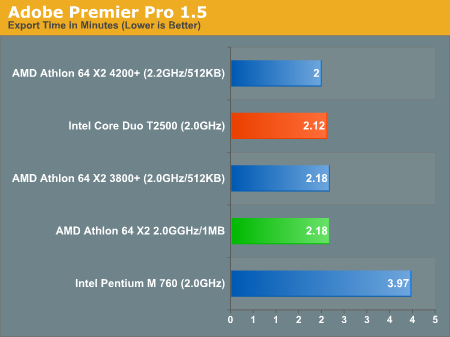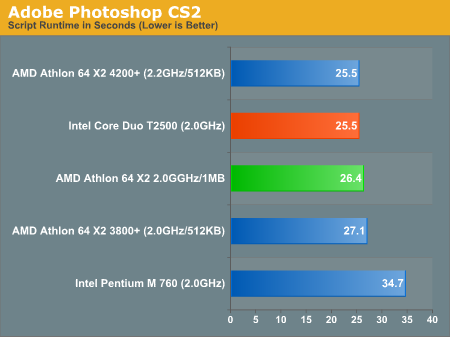Intel Core Duo (Yonah) Performance Preview - Part II
by Anand Lal Shimpi on December 19, 2005 12:55 PM EST- Posted in
- CPUs
Professional Application Performance with 3dsmax, Adobe Premier and Photoshop
We start off our page on professional application performance with an updated version of the SPECapc 3dsmax test, updated for version 7 of the application. The scenes being rendered haven't actually changed, but the reference numbers used to compute the composite scores have, so these scores aren't directly comparable to results from earlier SPECapc tests.
Compared to the Athlon 64 X2, the Core Duo comes out on top, but by a very small margin - once again we're faced with a virtual tie.
The breakdown of the rendering composite score can be found below; the scores in the table are render time in seconds, lower numbers are better:
Moving onto Adobe Premier Pro 1.5, this test is actually one that is used by Intel to showcase the performance of the Pentium 4 processor. With the Pentium 4 absent from this comparison, we were curious as to how it compared to the Core Duo and the Pentium M.
As with virtually any media encoding performance, dual-core processors do extremely well, and this case is no different with the Core Duo T2500 seriously outpacing the Pentium M 760.
The Core Duo T2500 is also able to complete the export process in about 97% of the time of the Athlon 64 X2, which once again ends up being borderline negligible for this test, but it is important to note that this advantage comes without the aid of an on-die memory controller.
Our final test is the only other Intel-supplied test in the suite. This one used to showcase the Pentium 4's performance under Adobe Photoshop CS2 by measuring the time that it takes to run a few filters and resize/export images. The script itself is fairly realistic; however, with Photoshop filters, it is easy to favor one architecture over another, so by no means are these numbers intended to be conclusive of Photoshop CS2 performance.
We start off our page on professional application performance with an updated version of the SPECapc 3dsmax test, updated for version 7 of the application. The scenes being rendered haven't actually changed, but the reference numbers used to compute the composite scores have, so these scores aren't directly comparable to results from earlier SPECapc tests.

Compared to the Athlon 64 X2, the Core Duo comes out on top, but by a very small margin - once again we're faced with a virtual tie.
The breakdown of the rendering composite score can be found below; the scores in the table are render time in seconds, lower numbers are better:
| SPECapc 3dsmax 7 Breakdown | AMD Athlon 64 X2 4200+ | AMD Athlon 64 X2 3800+ | AMD Athlon 64 X2 2.0GHz/1MB | Intel Core Duo T2500 | Intel Pentium M 760 |
| 3dsmax 5 rays | 15.406 | 15.829 | 16.109 | 14.297 | 25.246 |
| CBALLS2 | 20.125 | 22.281 | 22.094 | 21.187 | 42.201 |
| SinglePipe2 | 92.844 | 101.906 | 101.922 | 107.359 | 203.492 |
| UnderWater | 142.938 | 157.219 | 156.203 | 169.188 | 316.055 |
Moving onto Adobe Premier Pro 1.5, this test is actually one that is used by Intel to showcase the performance of the Pentium 4 processor. With the Pentium 4 absent from this comparison, we were curious as to how it compared to the Core Duo and the Pentium M.

As with virtually any media encoding performance, dual-core processors do extremely well, and this case is no different with the Core Duo T2500 seriously outpacing the Pentium M 760.
The Core Duo T2500 is also able to complete the export process in about 97% of the time of the Athlon 64 X2, which once again ends up being borderline negligible for this test, but it is important to note that this advantage comes without the aid of an on-die memory controller.
Our final test is the only other Intel-supplied test in the suite. This one used to showcase the Pentium 4's performance under Adobe Photoshop CS2 by measuring the time that it takes to run a few filters and resize/export images. The script itself is fairly realistic; however, with Photoshop filters, it is easy to favor one architecture over another, so by no means are these numbers intended to be conclusive of Photoshop CS2 performance.

Overall System Performance using WorldBench 5
Media Encoding Performance with DVD Shrink, WME, Quicktime and iTunes










103 Comments
View All Comments
fitten - Tuesday, December 20, 2005 - link
Yup... as I posted above... the rumor is that Yonah was designed for 2.5GHz (maybe even 2.6GHz or so) and can easily be overclocked to those speeds but is being launched at the speeds it is for exactly what you say... to fit in a certain power envelope.Xenoterranos - Tuesday, December 20, 2005 - link
We'll, that's definitely a logical argument, but I'd say only marginally relavent to this discussion. If a laptop with X% better power consumption comes out, does it really matter in the end where those X% came from. I can see the validity in saying that maybe some of those optimizations are on the board and thus the CPU shouldn't be given all the credit, but lower consumption is lower consumption. But that's all hypothetical. The reality is that even without optimizations, the Pentium M would have enjoyed lower power consumption just by moving to the 65nm proccess, as would any proccessor. that's where most of that 30% came from. I'd venture to say that the board design provides 1 or 2 % max, and definitely within the margin of error.><eno
Xenoterranos - Tuesday, December 20, 2005 - link
Um, i got confused there a bit. I'm basically saying that the new "Core Duo" derives the majority of it's efficiency not from any architectual changes (although they do help a lot), but from the move to 65nm. When AMD makes that jump to (and if Intel hasn't already gone to 45nm) then you'll see AMD pull ahead in power consumption on all 65nm parts, if not performance as well. Remember, aside from the on-die controller, this new architecture is very similar to what AMD is doing. Like the author said, if they wanted to copy something, they should at least copy the serial bus!Betwon - Tuesday, December 20, 2005 - link
All one know that Dothan is 90nm.But it is very cool. hot == Intel's 90nm? No!The CPU's architecture of low power consume is key. We must understand that IC design is very complex, many advanced tech are applied to keep CPU cool, include the CPU's architecture(such as micro-ops fusion).
Furen - Tuesday, December 20, 2005 - link
Yonah is better? It seems to be like its a pretty even match clock-for-clock but if you consider that X2s max out at 2.4GHz (currently) and Yonah will launch in around 15 days at 2.13GHz (the FX-60 is supposed to launch around the same time, so the X2 max clock may hit 2.6GHz when Yonah arrives) then it is clearly inferior in the performance department. Granted, the power consumption is quite a bit better but I'd hardly say that the CPU is better, just better suited for low-power applications.Betwon - Tuesday, December 20, 2005 - link
Yonah(2GHz/L2 2M) is better than AthonX2(2GHz/L2 2M) in the many cases.Everyone also believe that Yonah is able to reach the very high frequency.
In the past, We also known that PM can be overclocked better than A64. The PM's best record of Super Pi is much fast than A64/FX.
Zebo - Monday, December 19, 2005 - link
Yonah Yonah Yonah... Nah it was hype as I suspected... these procesors are vitually identical to AMD's old A-64's.. AMD supposed to get signifigant bumps w. DDR2/3 and PCIe onboard plus I read about some technology AMD and IBM made to increase performance by a whopping 40%!!http://www.guru3d.com/newsitem.php?id=3370">http://www.guru3d.com/newsitem.php?id=3370
AMD has nothing to fear other than in power arena when longer pipe Conroe comes and even then that advantage may very well disappear.
IntelUser2000 - Tuesday, December 20, 2005 - link
The 40% advantage is TRANSISTOR performance. Even then, its 40% advantage when no straining is included at all. AMD has strained silicon in their current process. Which means real advantage is FAR less than 40%.Shintai - Monday, December 19, 2005 - link
PCIe onboard is not a speed advantage. It´s more a tactic move towards the the computer on a chip solution.AMD is keen on ondie memory controller and in some years PCIe aswell due to the fact they suck at chipsets. Sure nVidia is making some good ones now. But it´s always been Intels extra strong point.
PCIe would also gives less traces on the motherboard that gives lower cost. But your CPU will break the 1300pin mark atleast and will be unable to scale in any way. Like AMDs backwards setting with DDR. When some new PCIe or more PCIe lanes comes out. You would need a new socket.
However personally I´m in favour of it. I just think AMDs ondie solutions is the wrong way. On package seems alot better and more flexible. Until we have an even more stagnant development cycle for external parts.
stateofbeasley - Monday, December 19, 2005 - link
DDR2 advantage? I wouldn't count on it. The latency on DDR2 still sucks compared to DDR. I wouldn't be so quick to scoff - Yonah performs as well as the X2 while consuming only a fraction of the electrical power.I don't see why people thought Yonah was going to be some sort of X2 destroyer. Its execution core has far fewer units than K8 and it lacks an on-die memory controler. The fact that it can match an X2 with slimmer cores makes it all the more impressive. The only hype was in your mind.
The AMD/IBM technology is not in processors that we can benchmark today -- they have yet to bring this process to mass manufacturing.